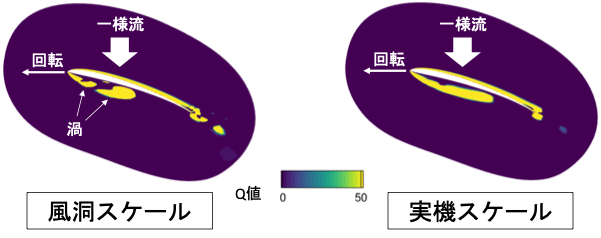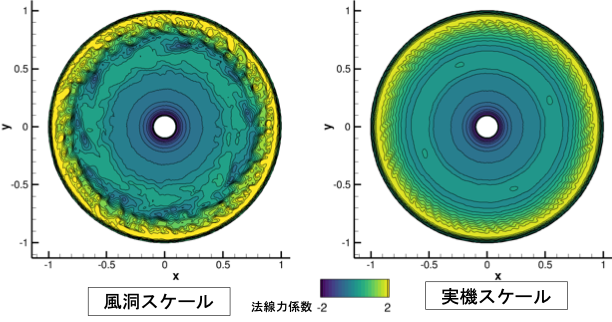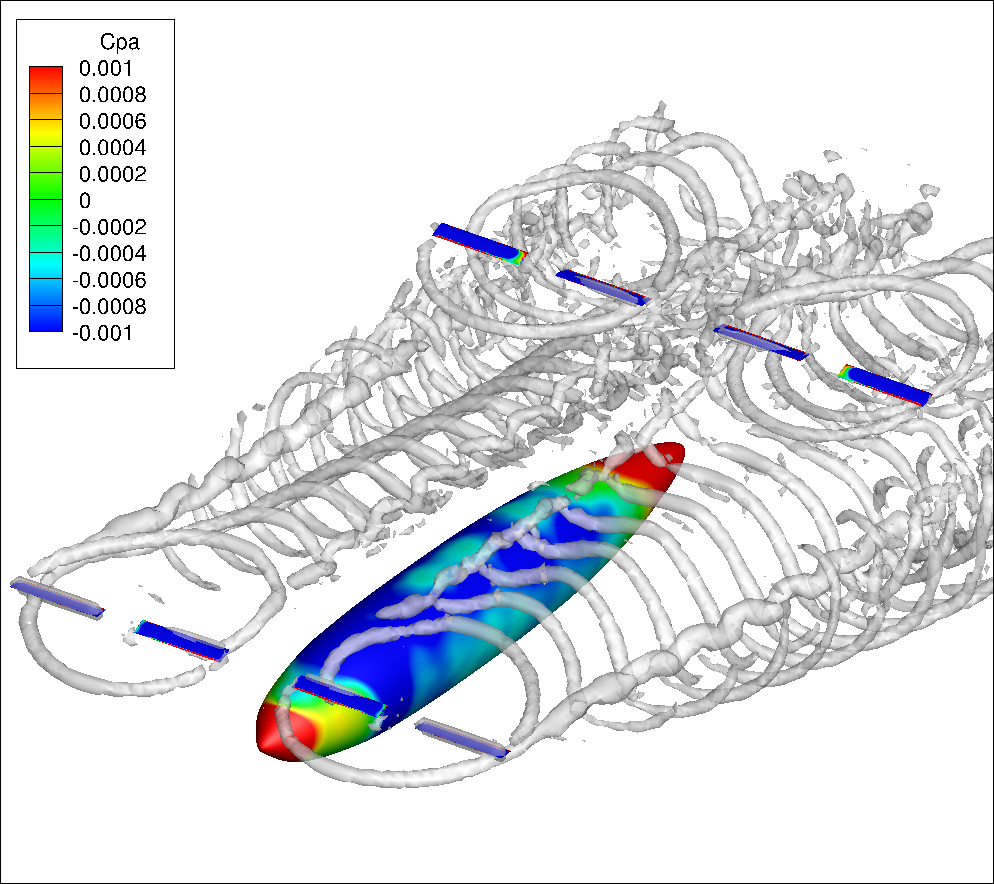Numerical Study on Propeller Slipstream Effects on Objects at Low Reynolds Number
JAXA Supercomputer System Annual Report February 2022-January 2023
Report Number: R22EACA43
Subject Category: JSS Inter-University Research
- Responsible Representative: Keiichi Kitamura, Associate professor, Yokohama National University
- Contact Information: Yoshikatsu Furusawa(furusawa-yoshikatsu-vz@ynu.jp)
- Members: Yoshikatsu Furusawa, Keiichi Kitamura, Keita Suzuki, Shunya Sakatsume
Abstract
As a new form of a Mars exploration vehicle, research and development of a propeller-driven Mars airplane are progressing. Because the low atmospheric density on Mars causes the flow around the Mars airplane at low Reynolds numbers, the flow field around the Mars airplane differs from airplanes flying in the Earth's atmosphere. Besides, it is known that the propeller slipstream interacts with the fixed-wing and the fuselage and affects their aerodynamic characteristics. These interactions are important aerodynamic phenomena on the Earth airplane like eVTOL, because they arise at high Reynolds number. In the present study, we conduct numerical simulations and intend to clarify the unsteady effects of propeller slipstream on the fixed-wing and the fuselage at a wide range from low Reynolds number to high Reynolds number regions.
Reference URL
N/A
Reasons and benefits of using JAXA Supercomputer System
We used JSS3 to perform large-scale three-dimensional numerical simulations using the flow analysis solver "rFlow3D" , "FaSTAR" and "FaSTAR-Move" developed by JAXA. JSS3 can perform fast and multiple calculations.
Achievements of the Year
In this work, unsteady numerical calculations simulating the wind tunnel experiments conducted at Tohoku University were carried out. Comparing flow around the wind-tunnel scale model (incompressible flow) and the actual scale model (compressible flow around the propeller), we investigated compressible effects around the propeller on the aerodynamics characteristics of the fixed wing within the propeller slipstream during the actual flight on Mars. The Propeller advance ratio and the Reynolds number on both scales are the same value; J = 0.8 and Re = 30,000. The propeller rotation speed is n = 4,500, and the angle of attack was set to 4 deg. In this case, the blade tip Mach numbers are Mtip = 0.10 for the wind-tunnel scale model and Mtip = 0.52 for the actual scale model.
Figure 1 shows the instantaneous Q-criterion fields (when the propeller is vertically upward) at the 63% position of the propeller span. Several vortices are shed from the separated shear layer over the blade in the wind tunnel scale model, while vortices are not formed in the actual scale model, suggesting compressibility stabilized the separated shear layer. Figure 2 shows the azimuthal normal force coefficient distributions acting on the blade within one propeller rotation. The azimuthal distribution of the actual scale exhibits weaker variation than that of the wind tunnel scale model. Hence, it was revealed that the compressibility stabilized the separated shear layer over the blade, leading to insignificant propeller vibration. Investigations of their effects on the fixed-wing, which is within the propeller slipstream, are ongoing.
In this work, unsteady calculations simulating level flight of the eVTOL at the high Reynolds number region were also carried out. Solving for the flow field between the propellers and fuselage, we investigated the aerodynamic interactions arising between them. The uniform flow velocity is M = 0.1 and the Reynolds number is Re = 3,700,000. The propeller rotation speed is n = 1800 rpm and the blade setting angle is 11 deg.
Figure 3 shows the instantaneous Q-criterion isosurface and surface pressure coefficient. The surface pressure is low along the wingtip vortexes generated by the propellers. Hense, it was revealed that the effect of the wingtip vortex on aerodynamic interactions. Investigations of the three-way aerodynamic interavtion, including not only the fuselage and propellers but also the fixed wing, are ongoing.

Fig.1: Instantaneous Q-criterion fields (when propeller is vertically upward) at 63% position of propeller span.

Fig.2: Azimuthal normal force coefficient distributions acting on blade within one propeller rotation.
Publications
- Peer-reviewed papers
Furusawa, Y., Kitamura, K., "Stability effect of multidimensional velocity components in numerical flux SLAU," International Journal for Numerical Methods in Fluids, 2023 (Accepted).
- Oral Presentations
Furusawa, Y. and Kitamura, K., "Roles of Multi-Dimensional Velocity Components in All-Speed Numerical Flux SLAU," AIAA Paper 2022-4033, 2022.
Furusawa, Y. and Kitamura, K., "Stability Effect of Multi-dimensional Velocity Component on Compressible All-speed Scheme, Part II: Investigation on More Extensive Mach Numbers," 36th Computational Fluid Dynamics Symposium, 2022.
Keita, S., "Numerical analysis of the effect of rotor position on eVTOL aircraft aerodynamics," 60th aircraft symposium, 2022.
- Poster Presentations
Furusawa, Y., Kitamura, K., Ikami, T., Okawa, M., and Nagai, H., "Numerical Study on Propeller Scale Effect on Flow Field around Blade," 19th International Conference on Flow Dynamics, 2022.
Keita, S., "Numerical analysis of the effect of rotor position on eVTOL aircraft aerodynamics," 2022 JSAE Annual Congress (Spring), 2022.
Usage of JSS
Computational Information
- Process Parallelization Methods: MPI
- Thread Parallelization Methods: OpenMP
- Number of Processes: 36 - 1440
- Elapsed Time per Case: 720 Hour(s)
JSS3 Resources Used
Fraction of Usage in Total Resources*1(%): 0.25
Details
Please refer to System Configuration of JSS3 for the system configuration and major specifications of JSS3.
| System Name | CPU Resources Used(Core x Hours) | Fraction of Usage*2(%) |
|---|---|---|
| TOKI-SORA | 2086241.03 | 0.09 |
| TOKI-ST | 1193760.00 | 1.19 |
| TOKI-GP | 0.00 | 0.00 |
| TOKI-XM | 0.00 | 0.00 |
| TOKI-LM | 16157.76 | 1.08 |
| TOKI-TST | 0.33 | 0.00 |
| TOKI-TGP | 0.00 | 0.00 |
| TOKI-TLM | 0.00 | 0.00 |
| File System Name | Storage Assigned(GiB) | Fraction of Usage*2(%) |
|---|---|---|
| /home | 20.33 | 0.02 |
| /data and /data2 | 25720.00 | 0.20 |
| /ssd | 1876.67 | 0.26 |
| Archiver Name | Storage Used(TiB) | Fraction of Usage*2(%) |
|---|---|---|
| J-SPACE | 6.07 | 0.03 |
*1: Fraction of Usage in Total Resources: Weighted average of three resource types (Computing, File System, and Archiver).
*2: Fraction of Usage:Percentage of usage relative to each resource used in one year.
ISV Software Licenses Used
| ISV Software Licenses Used(Hours) | Fraction of Usage*2(%) | |
|---|---|---|
| ISV Software Licenses(Total) | 5237.39 | 3.64 |
*2: Fraction of Usage:Percentage of usage relative to each resource used in one year.
JAXA Supercomputer System Annual Report February 2022-January 2023



